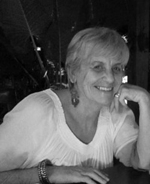
This is Lynne Fellowes’ second book. Her first, “No Room for Watermelons”, a travel adventure, was published by High Horse in 2013. Previously, one of her stories, “The Conondale Ball”, was adapted as a stage production and featured in the children’s television program, Totally Wild. When not writing, Lynne works as an artist in her Huon Valley studio. Having lived abroad and travelled extensively, Lynne now calls Tasmania home.
Lynne’s Other Pages
Living in the Huon Valley I’m surrounded by nature. Seeing wedge-tail eagles and black cockatoos flying overhead is thrilling and I wanted to capture that sense of wonder in a children’s book. I also wanted the story to not only be educational, but to provide hope and encourage families to explore what they could do to make a difference.
We rescued scores of flying foxes (bats) from aquaculture farms where they got caught in the netting. In the evenings they would hang upside down off my shirt and flap in readiness for when the tears in their wings healed. They are incredibly affectionate and fascinating to watch with their babies suckling under their armpits
I’m a huge fan of ecologist Dr Rachael Alderman who goes to secluded Albatross Island and camps in a cave from Sept – October each year to study the Shy Albatross. “Every species needs a champion,” she says. I heartily agree. To have people like Rachael doing such invaluable work gives me hope that we can save endangered species. Of course species like the hairy red snail and the blind velvet worm sounded so appealing that I just had to include them in the book.
Ladybirds are unsung heroes. They are an important biological control for aphids and other pests in the garden. One female ladybird can eat 2500 aphids in her lifetime. Although they are not endangered, ladybirds, like spiders and bees are vulnerable when we use pesticides. Jennifer Wright, the book’s illustrator came up with the idea for the ladybird. We both love them and I think they are every child’s favourite bug.
